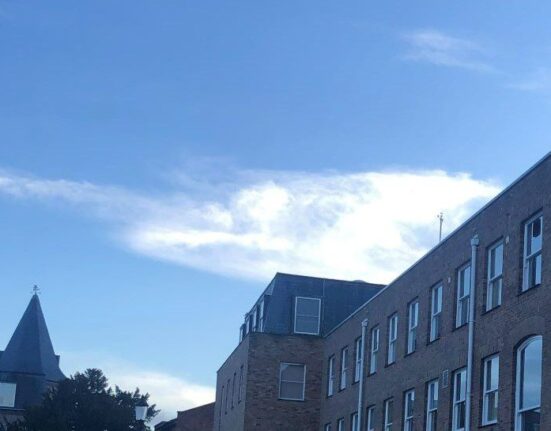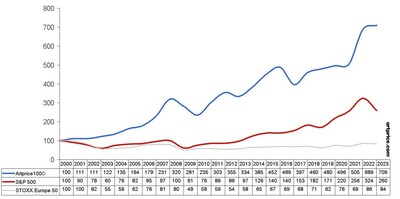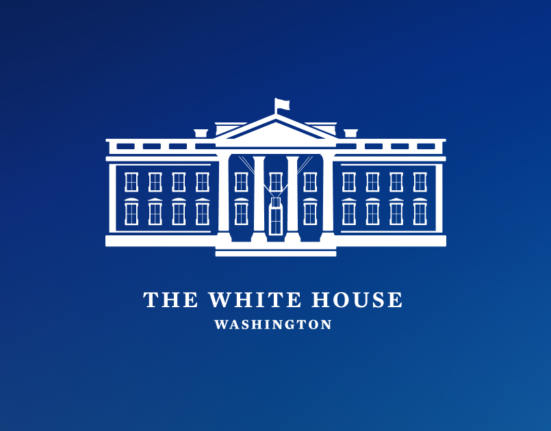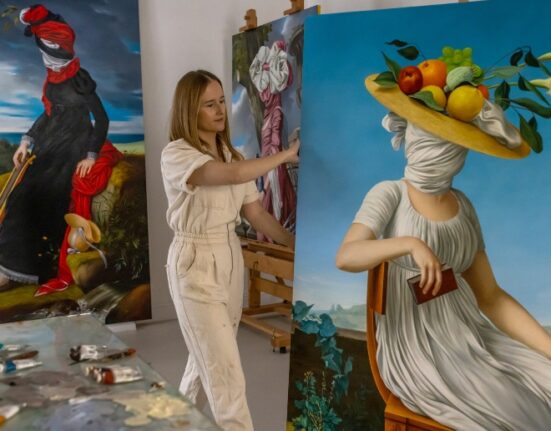HONG KONG, CHINA – OCTOBER 04: Visitors experience an immersive art installation titled “Machine … [+]
In the history of any creative industry, the relationship between tech knowhow, artistic acumen, and “cold hard cash” has been akin to a chicken versus egg dilemma. What inspires change? What drives innovation? The coronavirus pandemic has dramatically exposed transnational cultural and socioeconomic fault lines. It has also exhibited the transformative power of the global creative community to comfort, sustain, and encourage all of us through an unprecedented crisis. From news coverage to e-commerce and edutainment, technology has entered another breakthrough era. Investors, hypersensitive to pivots in potentialities, are casting their multimillion-dollar votes of confidence in the arts and tech market.
TOKYO, JAPAN – 2021/06/25: Digital artwork form different artists is seen on a wall one day before … [+]
In 2020-2021, this “niche” has received nearly 60% of the industry’s total investment over the last two decades. Sotheby’s has just made its first crypto-investment with $20 million going to the NFT studio Mojito. The game-changing, history-making platform Masterworks.io which offers fractional ownership of art secured an additional $110 million investment this month. To better understand the synergy and its impact of emerging talent, I reached out to folks at the vanguard of this trend: the Art+Tech start-up accelerator Fuelarts which recently held its Demo Day, the upcoming Science in Theater Festival organizers, and top art investment analysts.
Both tech and art markets are prone, in equal measure, to “overnight” success and failure stories. What makes this intersection a viable investment opportunity?
Denis Belkevich, founder, Fuelarts: As assets, after every boom or bust cycle, both art and tech prove to be some of the most resilient. Technologies make tough times smoother, and as soon as economic optimism picks up art prices are on the rise. In fact, art can go up in value even when stocks crash which is great for long-term investment. During the pandemic, consumers and businesses prioritized virtual connections, transparency of transactions, and simplified logistics. As a result, from now on, art and technology will develop together in a symbiotic relationship.
Adriano Picinati di Torcello, Global Deloitte Art & Finance Coordinator: Over the last 18 months, the COVID-19 pandemic has sparked more digital innovation and risk-taking than in the entire past decade. The traditional art market is on the cusp of a revolution, potentially redefining what it means to be a 21st Century art business. Art and tech investors are not necessarily artistic philanthropists, they tend to have a strong interest and understanding of the ecosystem and a desire to transform it. The number of specialized players addressing the friction points between the art and finance industry continues to grow and gain maturity. Better integration of art market analytics and collection management systems, technology facilitating cost-effective due diligence, and new technology-driven investment products are exciting spaces to watch. Blockchain technology is becoming more and more mainstream and new developments in DeFi, such as security tokens, could accelerate wealth managers’ interest in non-bankable assets such as art and collectibles.
How would you describe the art and tech common trajectory moving forward?
Belkevich/Fuelarts: Until 2020, art and tech startups mainly focused on four categories: transactions (marketplaces and payment systems), collection management (logistics, storage, expertise), information (databases of auctions and artists’ activities and financial benchmarks), and research and development. Now two more categories emerged: visualization and gamification. Augmented reality, mixed reality, and virtual reality are connecting creators and audiences beyond (online) showrooms. Then, we are seeing the integration of a game element into all existing areas of the art market, including the emergence of specialized online games and new dynamic hybrid categories. This particularly appeals to younger buyers, the most desirable, but unreachable clients.
Transforma Theatre, a New York based not-for-profit with a mission to create interactive theatrical … [+]
Reaching people “where they are at” is an important part of making any change in society. This moment feels critical for credibility and bankability of science and technology. How can the arts help popularize this trust and educate people further?
Tjaša Ferme, Founding Artistic Director of Transforma Theatre, Creative Director of Science in Theatre Festival: That’s what our festival is doing – bringing science out of the closet. Theatre takes science and technology out of the ivory tower and places it in an environment where people can engage directly and interact. In my opinion, this engagement is what has been most lacking. Science has traditionally been secluded from the public eye and tech companies struggle to hold public’s attention when there’s always too much background noise. The purpose is to get young people and entrepreneurs to come, to contemplate deeper questions and possibly be inspired to build new tech products for the arts. How we value art influences how we invest in it. If we valued it as something substantial, not just whimsical and emotional, then the media and the public would have more respect for its place in society. And investors would show a different level of dedication.
This picture taken on June 25, 2021 shows CEO of the BAE, a crypto art platform, and the … [+]
Let’s talk about algorithms. We accepted machine learning in tech and science as part of the process. However, the impact of Artificial Intelligence on the arts is an open question…
Playwright Saviana Stanescu, winner of the New York Innovative Theatre Award for Outstanding Play: Theatre, technology, and science learn from each other, and in a way, they are similar. Generally, artists and scientists are very experimental, adventurous. There’s a risk that AI could be used to oppress people, and the scientists involved would be complicit in that oppression, so I think the ethical aspect is very important. We need to be very careful with how we employ things that we build. Technological innovation doesn’t exist in a vacuum; even scientific discovery for its own sake will have practical applications and ethical implications. We need to work together toward a greater good.
Belkevich/Fuelarts: The auction results for AI-created artwork ($432,000 in 2018 at Christie’s) have been impressive, but further decline in demand showed that collectors understand the difference between art and provocation. The main criterion that determines the value of art is still the artists themselves, their experiences, and how they interpret those experiences. For the artist, technology has always been either an object of exploration or a means of expression. Those artists who aim to subjugate technology, or to express themselves only by technical means, without a human touch, eventually disappear from view. When art is created by someone with an profound personal history, it tends to attract more buyers and make a lasting impact.
LONDON, ENGLAND – JUNE 04: Mario Klingemann’s Mitosis goes on view as part of ‘Natively Digital: A … [+]
What advice would you give people considering investment in the art and tech market?
Andrey Lebedev, LP at venture capital fund Amadeo Global: I can speak from my experience investing in fast-growing, socially responsible businesses that scale up globally. I’ve been focusing on EdTech for years when nobody believed it can bring a substantial profit. I believe Art and Tech is another promising category. Opportunities are there, the tools are there, and in the next 10 years the art world could be a wonderful place for investors. The pandemic created this moment when everything freezes, but there’s always Renaissance after a crash. You don’t need to understand the entire art world and the technical side. Most investors are aware of one side. If you know technology, you could learn more about art, and vice versa. But you need to have passion for this.
Belkevich/Fuelarts: We are witnessing a generational shift in the arts and business worlds. The Silent Generation, shaped by broadcast technologies in the 1960’s and 70’s, are being replaced by Millennials and Gen Z guided by interactive social media. These new collectors have a desire for transparency and fun. The pandemic made contemporary emerging artists more accessible and desirable. Demand and prices for works by established artists stalled because museums and auctions went into lockdowns halting the logistics of the physical art world. At the same time, the fresh talent’s activity on social media increased their value several times over. Today the physical and digital art worlds are like two planets, each with their own inhabitants and codes of conduct. The main question concerning the market now is how easily these two worlds would merge.







